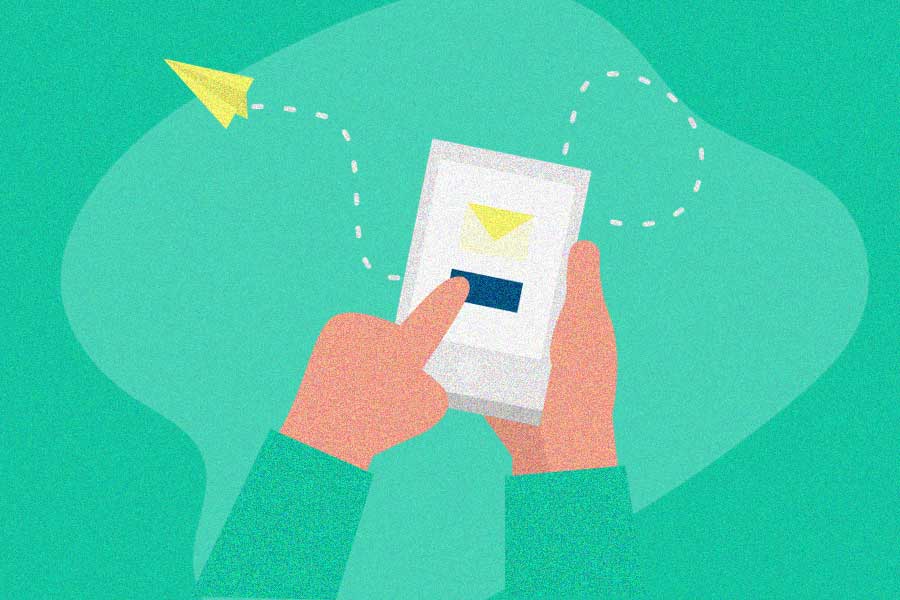What is the Net Promoter Score or NPS survey? And what are the NPS questions?
An NPS survey is a simple survey question that a brand sends to customers, in order to get a concise understanding of their satisfaction level with that organization or brand. This survey aims to help quantify customer loyalty and customer satisfaction. At the same time, it collects customer feedback that will help improve the customer experience. Usually, an NPS survey is a two-part survey that consists of a rating question and a free-response follow-up.
The rating question (main NPS question)
The first part of the NPS survey is a single question where respondents pick a numerical score between 0 and 10. The question is always worded similarly to the example below, and is always focused on assessing how likely the customer is to recommend you to a friend, colleague, or peer.
“Considering your complete experience with our company, how likely would you be to recommend us to a friend or colleague?”
![NPS Questions to Gauge Customer Satisfaction [+ Examples] 1 example of NPS questions](https://referralrock.com/blog/wp-content/uploads/2019/09/nps-question-2018-1024x369.png)
Image by SurveyMonkey
The higher the score, the more likely customers are to recommend your company to their friends or colleagues. On the other hand, the lower the score, the less likely they will spread the positive word about your business. This part allows your customers to speak their minds in private.
The follow-up (open-ended question)
The second part of the question is the follow-up, which invites your customers to leave feedback in their own words why they would or would not consider recommending a company. This allows respondents to provide context for their chosen numerical score.
The follow-up question tends to be very crucial as it allows a brand or organization to get valuable feedback from their clients.
As a marketing manager, you’ll find that this is the question that will truly help you in tracking the results of a particular marketing campaign, measuring customer loyalty, and transposing the collected data into a long-term growth strategy.
Personalizing the follow-up question is very crucial. Keep in mind this question is open-ended. Fortunately, some NPS tools can even help you customize this question depending on the score the respondent gives in the first (rating) question.
Below are a few examples of follow-up questions:
- What is the main reason for your score?
- How can we improve your experience?
- What do you like most/least about (product or company)?
- What was disappointing or missing in your experience with us?
- Which features do you value the most?
How do you interpret NPS?
After surveying your customers, responses to your question will fall into these three groups.
- Detractors: Customers who answer the question with 0-6. They are unhappy customers who are unlikely to buy from you again, and who may even discourage others from buying from you.
- Passives: Customers who answer the question with 7 or 8. These customers are satisfied with your service, but not happy enough to be considered promoters.
- Promoters: Customers who answer the question with 9 or 10. They are typically loyal and enthusiastic customers, and they are your best advocates.
These categories will help you better understand your target audience, and can perhaps give you insight on what you need to market better towards certain individuals.
Why are NPS questions so important?
NPS questions help you identify your most loyal advocates. If a happy customer is willing to promote your business, they’re much more likely to buy again, forgive your business in case a mistake occurs, and much more likely to try a new offering compared to unhappy customers.
Also, NPS measures overall customer loyalty. Customer NPS helps businesses evaluate customer loyalty, the likelihood of them recommending their businesses, and the likelihood of them not purchasing from you in the future or canceling their subscriptions. In other words, customer NPS provides an easy way to retain existing customers as well as attract new ones.
Crucially, NPS boosts referral marketing. Customer NPS offers an easy way to get recommendations from happy customers. Asking them to write reviews through the comment box is one way of tempting new customers. Alternatively, you can ask them to share emails of potential customers who might be interested in your services and products. Your promoters are the perfect people to ask about referring their friends through a referral program. (Be sure to check out our article for other ways to promote your referral program.)
NPS surveys help you prioritize reaching out to detractors. One customer’s bad experience with your brand could cost you your business. In fact, customers are more likely to talk about a bad experience, and tend to tell more people about it. Customers tell an average of 15 customers about a bad experience, compared to the average of 11 customers they tell about a positive experience.
Using a Net Promoter Score (NPS) helps you better understand these customers’ experiences. You’ll be able to identify dissatisfied customers at risk for churn, pinpoint why they aren’t satisfied, and work to make things right before they leave or talk negatively about your business.
Getting a score of 0 – 6 from unhappy customers who are unlikely to buy from you again should not put you off. In fact, treat such feedback as an opportunity to make what is wrong right. Or how best you can make such customers happy next time. You may even be surprised to find out that something small is causing some of your customers to feel unsatisfied.
NPS helps you identify ways to improve. Adobe reports that customer-centric businesses – ones that put customers first in all their business decisions and actions – grew revenue 1.4 times faster and increased customer lifetime value 1.6x more than other companies. The NPS scores you get, and the feedback gathered, will help your business make the necessary adjustments to be customer-centric. For example, you may find your customers are not happy with the time it takes for their products to be delivered. From that feedback, simply you will make the necessary adjustments.
Types of NPS surveys
Now let’s dive deeper and have a look at the two types of NPS survey that are used to benchmark customer experience and identify areas of improvement.
- Relationship (or relational) NPS: Relational NPS is designed to assess the strength of your relationship between a business or brand with its customers. It offers an excellent way to benchmark the customer experience. In other words, it helps measure loyalty to your brand based on the overall score.
- Transactional NPS (tNPS) : A tNPS is used to assess the customer’s opinion on a specific business transaction. For example, post services interaction, post-purchase, or post onboarding. This survey aims to help pinpoint what needs to be improved about specific customer experience.
NPS question templates
Unlike other questions you will have for your customers, an NPS question, though it may look simple, it is supposed to be specific to your goals. You can set the context of your question using a short message before the survey. Below are some of the common NPS questions examples.
- For customer personalization: If contemplating asking people about your products and services within a professional environment, consider using words like colleague and friend interchangeably.
For example, in the context of a family, you can add “family member.” In the context of your colleague, you can add “friends”. You can also combine the two in your question, “friends and family members.” See the example below for more details:
- “On a scale of zero to ten, how likely are you to recommend our products to a family member or colleague?”
- “Why would or wouldn’t you recommend this product to a friend or colleague?”
- For transactional NPS (tNPS): If looking to gather feedback on a specific interaction, include “based on your most recent interaction” to the question. If you pick the right words, tNPS question will be very helpful in your surveys.
- For product feedback: You can also use an NPS survey to get detailed customer feedback on your product or feature.
- How likely are you to recommend our products to a friend or colleague?
- On a scale of zero to ten, how likely are you to recommend our products to a friend or colleague?
- What can we do to make our product better or more satisfying to you?
- For gauging employee satisfaction: You can also design NPS questions for your employees, such as when you’re trying to find out what is motivating to them. This type of survey is known as employee NPS or eNPS.
See the examples below:
- On a scale of zero to ten, how happy are you with your workplace?
- What is the one thing we could do to make you happier in the workplace?
- What is that one thing that is holding you back from referring your family/friends to this organization?
eNPS surveys are very crucial for any company because unhappy employees will rarely speak up about major issues. Carrying out a survey helps unearth the detractors before it is too late to act. Besides, an eNPS can help point out passive colleagues that are neither satisfied nor unhappy about their workplace, and your company’s promoters, who will recommend your company as a place to work at.
When to send your NPS survey
The best time to send or conduct a survey is after your customers have had a complete experience with your products and services. For example, send the survey shortly after a customer makes a purchase, or after a subscription period has expired. Doing so allows the customer to give feedback while having fresh, accurate details about your products and services.
Now, let’s dive into optimum NPS survey timing for specific NPS types.
- Relationship NPS survey timing: To have up-to-date information on how your customers feel about your brand, consider surveying them often (but not too often that it becomes annoying). For example, you can do it after a month (especially if you have just gone through major changes or are making changes within the company), quarterly, or semi-annually. But always feel free to survey them when you find it appropriate.
- tNPS survey timing: Unlike the relationship NPS survey, tNPS are one-off surveys, and it is recommended to gather feedback immediately after an interaction has taken place. For example, gather feedback shortly after helping a client resolve an issue. You need to gather feedback promptly because tNPS are tied to customer interactions.
NPS survey length
Unlike the traditional form survey, an NPS survey is brief. The two-question format allows you to get better response rates than traditional surveys. However, you can add more questions if needed.
Using NPS tools allows you to generate follow up questions based on the initial customer rating making getting notable feedback quite easy. To keep the survey as efficient and effective as possible, limit yourself to 10 additional questions.
Personalizing the thank-you message
At the end of the survey, it is always a good idea to express your gratitude to your customers. They have taken their time to complete a survey for you. That is a good reason why they deserve your appreciation. A thank you message is one excellent way to show your appreciation. You can also offer them freebies such as eBooks or coupons. You have the freedom to show your appreciation in the best way possible.
Below are samples of thank you messages you can send at the end of your survey. They are based on the three groups of respondents aforementioned.
Promoters
“Thanks for your feedback. It is great to hear that you are proud of (our company or product). Your feedback helps us discover new opportunities to improve (our company or product) and make sure you have the best possible experience.”
Passives
“Thanks for your feedback. Our goal is to create the best possible product, and your thoughts, ideas, and suggestions play a major role in helping us identify opportunities to improve.”
Detractors
“Thanks for your feedback. We highly value all ideas and suggestions from our customers, whether they are positive or critical. In the future, our team might reach out to you to learn more about how we can further improve (our product or service) so that it exceeds your expectations.”
Ways to improve NPS questions
How can you improve your existing NPS questions? Follow these best practices.
- Keep it short: Most customers, after completing a purchase or service request, they shift their attention to other things. Sending a short NPS question immediately increase the chances of getting feedback. Remember, most customers will not have the time to go through a length question. So, make sure to send them a short and easy-to-read question as this will trigger them to leave feedback even when busy.
- Add a comment box: Including a commenting box or space for a detailed follow-up helps get more qualitative information from your customers. For example, a customer can use this section to explain why he or she picked a specific score. So, to get detailed information on why a customer is happy or unhappy, consider adding a comment box after the NPS question.
- Be Specific: Don’t beat around the bush by adding unnecessary words in your question. Just be specific. For example, if you want to get feedback about your products or features, make sure the question is well-tailored. You can even highlight products or features you are referring to when asking your customers to provide NPS.
Wrapping things up
Knowing what questions to ask, who you should ask, and when to ask are important. NPS software can help automate most of the process. To make things even better, you can pair an online reputation management software and referral program together to entice customers marked as ‘promoters’ to promote your product in one automated swoop.

![NPS Questions to Gauge Customer Satisfaction [+ Examples] 2 net promoter score](https://referralrock.com/blog/wp-content/uploads/2019/09/net-promoter-score-1.jpg)



